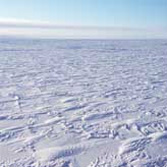Ice Drift and Deformation
Ice drift is one of the most important features of the Antarctic pack ice. Because the pack is unconstrained by land it is highly mobile, with the speed and direction of drift dependent on the winds and ocean currents.
The nature of the ice drift is most important in determining the sea ice thickness distribution, which in turn determines the degree of interaction between the ocean and the atmosphere. The net drift of the pack is divergent, but frequent periods of convergence cause floe deformation. Divergence of the pack is commonly associated with southerly winds which cause the ice to be advected northward. This creates open water areas between the floes, allowing rapid ice growth (in the form of frazil) to occur in these areas. Northerly winds cause the pack to converge, increasing the ice concentration and thickening the ice by rafting and ridging. The passage of low pressure systems causes the pack to undergo cyclical periods of convergence and divergence due to fluctuating wind directions. The importance of ice drift to the sea ice thickness distribution is evident in the ice core analysis mentioned previously, where the mean percentage of frazil crystals comprising the East Antarctic pack was found to be 47% - almost half of the ice mass for that region. This is in stark contrast with the Arctic, where frazil ice comprises only about 5% of the total ice mass.
The HI HO HI HO experiment conducted in August 1995 observed the motion of an array of drifting buoys during periods of expansion and compaction associated with the passage of low pressure systems through the pack. A close relationship was seen between wind speed and direction and the speed and direction of the drift of the buoys, suggesting that in the short term, the ice is largely decoupled from the ocean and responds primarily to the wind stress. The influence of the ocean currents on the drift of the ice is experienced over longer time scales.
Persistent katabatic winds which drain off the continent maintain open water areas in the form of coastal polynyas by advecting the constantly forming new ice northwards. These polynyas act as "ice factories" and make a disproportionately large contribution to the total ice mass of the pack per unit area.

